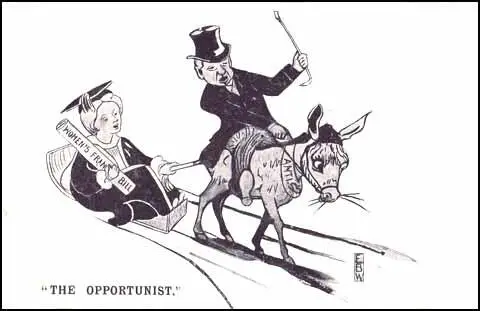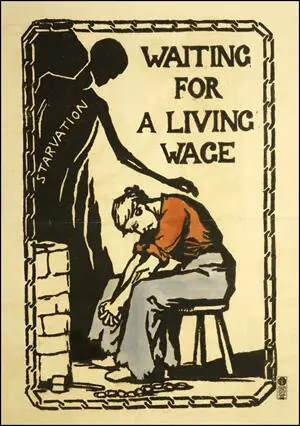Ethel Willis
Ethel Blanche Willis, one of nine children of Richard Willis and Ellen Sachs Willis, was born in Islington, in 1870. Richard Willis, was a successful manufacturing jeweller and by 1881 the family was living a large detached house in Camden Road where they employed three servants. (1)
After the death of her father her mother, and three of her children, moved into a smaller terraced house in Tooting. Ethel lived with her mother's brother, Frank Sachs, in Wood Green, who owned a jeweller shop in Oxford Street. In 1891 Ethel gave her occupation as a "governess", possibly educating Sachs' two young children. (2)
In May 1909, Alfred Pearse, Laurence Housman and Clemence Housman formed the Suffrage Atelier. This was an artists' collective campaigning for women's suffrage. (3) It claimed: "The object of the society is to encourage Artists to forward the Women's movement, and particularly the Enfranchisement of Women, by means of pictorial publications. Each member of the Society shall undertake to give the Society first refusal of any pictorial work intended for publication, dealing with the women's movement. In return the artist will receive a certain percentage of the profits arising from the sale of her or his work." (4)
As Lisa Tickner, the author of The Spectacle of Women: Imagery of the Suffrage Campaign (1987) has pointed out that along with the Artists' Suffrage League: "Women were able to organise collectively and contribute their professional skills to the suffrage campaign. They designed, printed and embroidered all manner of political material; they taught each other the requisite skills from hand-painting to needlework; they designed major demonstrations and took part in them in their own contingents; they lent their studios for meetings and contributed to exhibitions, bazaars and fund-raising activities." (5)
The Suffrage Atelier was based at 1, Pembroke Cottages, Edwardes Square, the home of Laurence Housman and Clemence Housman. Laurence described his sister as the organistion's "chief worker" and the main "banner-maker" of the women's suffrage campaign. (6)
Ethel Willis joined the Suffrage Atelier and became its secretary. In March 1909, her drawing, "The Opportunist", appeared in the Women's Franchise newspaper. (7) The card depicts a woman graduate holding a Women's Franchise Bill and being pulled along on her sledge by Prime Minister Herbert H. Asquith mounted on the Anti-Suffrage Society donkey. Soon afterwards the drawing was issued as a postcard. (8)

The Suffrage Atelier held meetings on the last Thursday in every month. At first they were held at Pembroke Cottages, Edwardes Square, the home of Laurence Housman and Clemence Housman. At a meeting in June, 1909, Laurence Housmen outlined the importance of the Suffrage Atelier. He argued that art had longed suffered from a lack of connection with life in this country. "Pre-Raphaelitism had been an attempt to re-unite art and national life, but the growth of internationalism in technique had not been connected with any international idea or inspiration, such as the Women's Movement now supplied. The pageants of the present day, the revival of old folk-song and dance, and of something resembling a national costume in the purple, green, and white – or green, gold, and white of the Suffrage societies, were signs of the renewal of the blending of art and life." He added that when England invaded other countries "it was represented by John Bull, but when a really national crisis intervened the national spirit was symbolised by Britannia, the woman. Our representative house, in its more heroic moods, called itself the 'Mother of Parliaments'; at present it resembled rather an absconding father." (9)
In 1909 Ethel Willis met fellow member, the artist, Hope Joseph, who became her lifetime companion. Joseph had studied at the Kensington Government School of Art in Berkeley Square. (10) In April 1909, Joseph began having her work published in Women's Franchise. This included "The Intolerable Burden of the Vote". (11)
Leading members of the Suffrage Atelier would take it in turns holding "At Home" sessions. By 1912 the group was meeting at her home at 6 Stanlake Villas, Shepherds Bush. One journalist was very impressed with one session she attended where Louise Rica Jacobs was showing her work: "The Atelier is run entirely by women artists, who make their own designs, cut blocks and do the printing of posters, postcards, Christmas cards and pictorial leaflets, the uniform of the women being a bright blue workmanlike coat, a black skirt, and a big black bow like that beloved of the artists who dwell near the Luxemburg." (12)
Ethel Willis was also active in the National Union of Women's Suffrage Societies campaign against the exploitation of women's labour. At a meeting at Wycombe Town Hall she provided an exhibition of work from the Suffrage Atelier: "These included posters, postcards, designs for advertisement, decorations, book illustrations, original lithographs, wood cuts, etc. all executed by women, whose work was much admired. This portion of the exhibition was organised by Miss E. B. Willis... The striking banners used in Suffragist processions, etc., are clever works of art and execution. Many of them are designed by leading artists who are interested in the movement." (13)

After the First World War Ethel Willis and Hope Joseph lived in Ashtead, Surrey. In 1939 the women were living together at 4 Ivinghoe Aston, Leighton Buzzard, Buckinghamshire. Joseph died in 1953. From her estate of £2,700 she left Ethel a legacy and the right to remain rent-free in the cottage for as long as she wished. (14)
Ethel Blanche Willis died on 13th December 1954, at her sister's home at 10 Nunn's Close, Hitchin. (15)
Primary Sources
(1) The Vote (23rd December 1911)
The members of the Suffrage Atelier held a Christmas party and exhibition of their work at the studio, 4, Stanlake Villas, Shepherds Bush, last Wednesday. In spite of the wet weather many friends arrived, each bearing a Christmas present, presents which ranged from a mangle to a file – all of great value to the Atelier…. After tea the guests inspected the work shown in the various departments, including original drawings and designs, posters, postcards, and Christmas cards, designed and printed at the Atelier. Mrs Vulliamy ( Katherine Vulliamy), of the Women's Freedom League, spoke on the work of the Atelier dwelling chiefly on its value to the Suffrage Societies and to women artists as affording them opportunities to experiment and also to become acquainted with processes of reproduction.
(2) The Vote (5th October 1912)
One of the most interesting products of the Women's Suffrage Movement has been the formation of the Suffrage Atelier which has its headquarters at 6 Stanlake Villas, Shepherds Bush. On Thursday, September 26, the Atelier was transformed into an exhibition of pictorial postcards, educational posters, and art needlework of every variety, including a varied show of Suffrage banners…
The Atelier is run entirely by women artists, who make their own designs, cut blocks and do the printing of posters, postcards, Christmas cards and pictorial leaflets, the uniform of the women being a bright blue workmanlike coat, a black skirt, and a big black bow like that beloved of the artists who dwell near the Luxemburg. Miss Willis was a charming hostess, and was admirably supported by Mrs. Tritton, Miss Jacobs, Miss Joseph, Mrs Waller, and other friends….
"At Homes" are being held at the Atelier on the last Thursday in every month, and anyone who wishes to spend a pleasant hour or two could not do better than avail themselves of the invitation to attend.
(3) The Vote (9th November 1912)
The monthly "At Home" of the Atelier was held as usual on the last Thursday of the month at its own workshops, 6, Stanlake Villas. On this occasion the members and friends of the Atelier from all the Suffrage societies – were entertained by humourous and other recitations by Miss Elian Hughes, who is about to start a speakers' class in the Atelier on Thursdays on 5.30 p.m. Mrs. Ambrose Gosling's beautiful lace and wonderful needlecraft were displayed upstairs. A one-woman show of clever water-colours and fine lithographs by Miss Louise Jacobs filled another room. Downstairs, Suffrage posters and postcards of the Atelier's own publication were on sale and on view, many of these being cartoons for the Vote and posters for the Caxton Hall meetings and the International Suffrage Fair at Chelsea Town Hall. The Atelier decorated the Caxton Hall at the Women's Freedom League Reception to the International Delegates on October 28, and exhibited posters which proved very attractive.
(4) South Bucks Standard (20th February 1913)
Forcible, object lessons as to the sweating of women in industries in various parts of the country were given to the public of Wycombe at the Town Hall, yesterday afternoon and evening, when under the auspices of the growing local branch of the National Union of Women's Suffrage Societies, an exhibition of sweated female labour was held….
They were some excellent examples of work from the Suffrage Atelier, at Shepherds Bush. These included posters, postcards, designs for advertisement, decorations, book illustrations, original lithographs, wood cuts, etc. all executed by women, whose work was much admired. This portion of the exhibition was organised by Miss E. B. Willis, of the Suffrage Atelier, whose headquarters are at Stanlake Villas, Shepherds Bush. The striking banners used in Suffragist processions, etc., are clever works of art and execution. Many of them are designed by leading artists who are interested in the movement.

